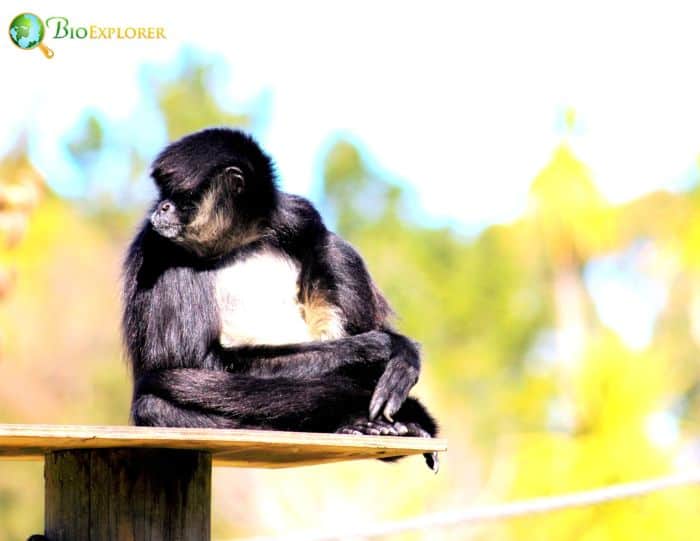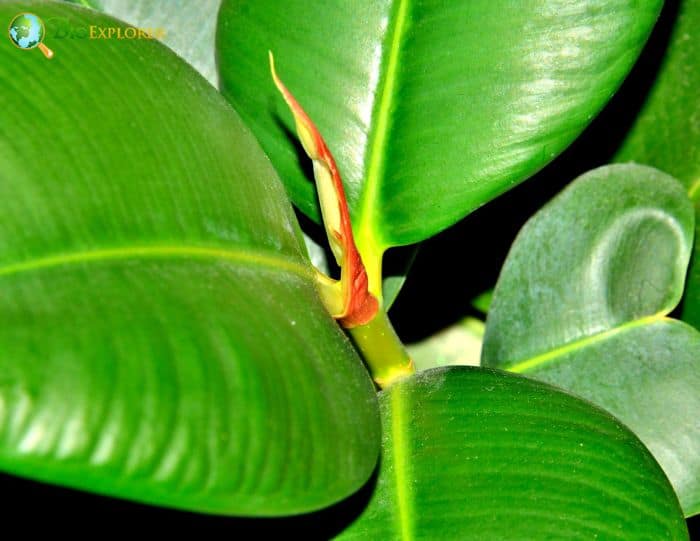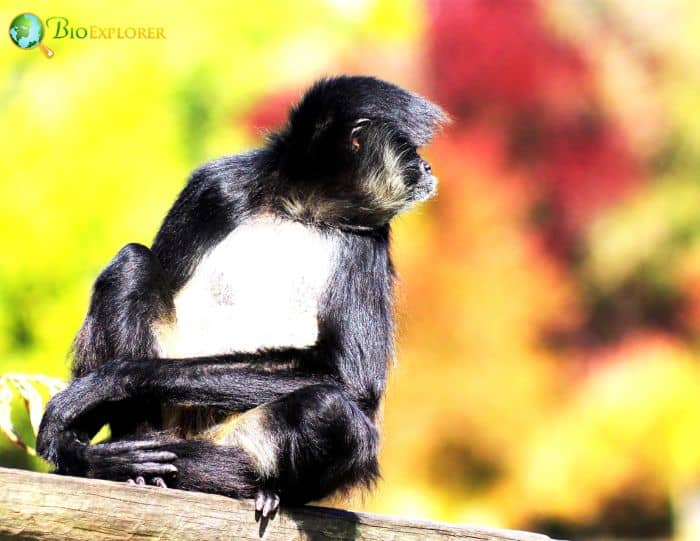
| Animalia | Primates | Atelidae | Ateles | Ateles belzebuth |


- Common Name: White-bellied Spider Monkey
- Taxonomy Classification Year: 1806
- Monkey Size: 34 to 59 cm (13.39 to 23.23 in)
- Skin Color(s): Black and yellow-creamy
- Habitat: Rainforest
- Diet: Herbivorous
- Native Countries: Colombia, Ecuador, Venezuela, Peru, Brazil
White-bellied Spider Monkey Distribution
White-Bellied Spider Monkey Characteristics

The white-bellied spider monkey[1] (Ateles belzebuth), also called the long-haired or white-fronted spider monkey, is an endangered species of spider monkey, a species of New-World monkey.
- It is found in the northwestern Amazon in Brazil, Colombia, Venezuela, Ecuador, and Peru, extending south to the lower Ucayali River and east to the Branco.
- The limbs of white-bellied spider monkeys are long, muscular, and very strong. In addition, its shoulders are such that its arms can fully rotate.
- The elbows allow the forearms to pronate, and the large carpal tendons make their wrists extremely flexible.
- Its hands are long, thin, and thumbless. Instead, their four long fingers form a perfect hook to help them swing on branches.
- Its torso is short. All of these characteristics perfectly match this monkey’s supportive mode of locomotion.
- Its long, muscular tail is broad at the base, thin at the tip, and can bend, twist, and curl. It’s prehensile and tactile.
- The underside is bare with ridges like those found on the undersides of the feet and hands. They have a narrow face with a tiny chin, narrow snout, and large sockets in which almond-shaped brown eyes are fixed.
- The skull is round, and its ears are similar to ours. White-bellied spider monkeys, which live in lowland forests, have blackish fur on their backs and front legs and creamy-yellow fur on their abdomens; those from mountain forests have a greater variety of colors.
What Do White-bellied Spider Monkeys Eat?

The White-bellied Spider Monkey diet includes[¶]:
- Amarillo (Guatteria punctata)
- Rabo De Ranton (Casearia aculeata).
- Pachiuba (Socratea exorrhiza)
- Fig (Ficus)
- Guamo (Inga acreana)
- Cuero De Rana (Laetia procera).
- Abiu (Pouteria caimito)
- Breadnut (Brosimum alicastrum)
- Caucho Rubber (Castilla ulei).
- Trichilia (Trichilia)
- Hinchahuevos (Sapium laurifolium)
- Maraximbé (Trichilia tuberculata)
- Guiana Brosimum (Brosimum guianense).
- Chalahuite (Inga acrocephala)
- Pacae Colorado (Inga alba).
- American Muskwood (Guarea guidonia).
- Hogplum (Spondias mombin)
- Figueira-Acreana (Ficus sphenophylla)
- Icecreambean (Inga edulis)
- Sweetwood (Nectandra membranacea)
- Maripa Palm (Attalea maripa).
White-Bellied Spider Monkey Facts

- These arboreal monkeys spend most of their time in the canopy. They rarely go down. When they do, they drink water, eat dirt, traverse a treeless area, or run away from an aggressive opponent.
- In the treetops, white-bellied spider monkeys move freely between branches. They can cover large distances quickly using various modes of locomotion.
- White-bellied spider monkeys live in groups of 6-25 individuals, sometimes more. Group size varies by area, with larger groups found in undisturbed patches of woodland.
- Male white-bellied spider monkeys patrol the boundaries of the group’s territory to repel potential invaders and can cause serious injury if they bite by an intruder.
- These spider monkeys also rub leaves on their bodies. The scents can be used as a natural insect repellent, but they can also signal social status and attract a mate.
Suggested Reading: Types of Monkeys
Cite This Page
APA7MLA8Chicago
BioExplorer.net. (2025, October 17). White-bellied Spider Monkey. Bio Explorer. https://www.bioexplorer.net/animals/mammals/monkeys/white-bellied-spider-monkey/.
BioExplorer.net. "White-bellied Spider Monkey" Bio Explorer, 17 October 2025, https://www.bioexplorer.net/animals/mammals/monkeys/white-bellied-spider-monkey/.
BioExplorer.net. "White-bellied Spider Monkey" Bio Explorer, October 17 2025. https://www.bioexplorer.net/animals/mammals/monkeys/white-bellied-spider-monkey/.











